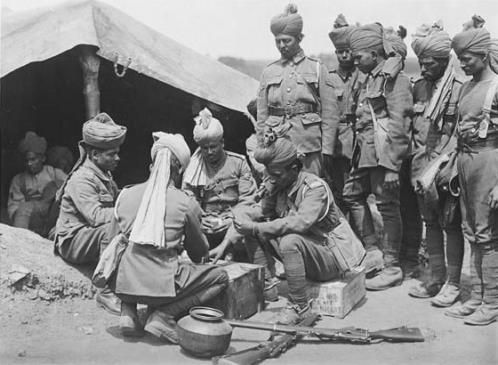
….. Continued from Part One … However the Indian Army did possess assets which according to their commander Willcocks never stood it in better stead than in France. These were the Indian Army officers who although small in number were comrades and friends of the sepoys, and sowars and were as loyal and brave as their soldiers.
Unfortunately this proved to be a double-edged sword for although commanders would rely on them throughout the campaign in France, death took its heavy toll day by day and these well trained leaders could not be quickly replaced.
There were also problems inherited from the army’s many years as a standing army of the British Empire. That almost all senior officers were British was one problem another was the low pay of the Indian officers compounded by the fact that at formal occasions, such as Durbars, they never received their proper share of what was referred to in North India as Izzat(honour)[i]. Many felt they were not treated with the respect which was their due and which had been earned in their long service on many fields before the outbreak of World War One. According to Willcocks this was a feeling very strongly held as Izzatwas a great driving force because it raised men in the estimation of their fellows, whilst the loss of it had the opposite effect
Under the Indian officers were the N.C.O.’s all of whom were in charge of a vast array of people from different backgrounds including: Rajputs, Jats, Pashtuns, Sikhs, Gurkhas, Punjabis, sappers from Chennai (Madras State), Dogras, Garhwalis and many others. Each had its own characteristics which needed to be recognised by anyone entrusted with the command of Indian troops. The colonial commander recognised that they could not all be placed in one mould but unfortunately this was not so clear when it came to the supreme commanders on the western front. As a result many of the clear roles and responsibilities which had been set up in India became confused and mixed-up as troops were split up and redistributed along the lines of the Western Front.
At Marseilles the Indian troops were camped either in their field service tents. Willcocks gave the following account to illustrate the strangeness of the situation both for the soldiers and the France locals. … take a look at the race-course by the sea. Leaning on the rails are twenty or thirty French, men, women, and children, watching our Indian soldiers cooking their evening meal; these have doffed their khaki uniform … they exchange words, French and Hindustani; a French child offers one of them a sweet, the Indian gives a cha-patty in return; cigarettes are offered by a passer-by; a Mohammedan pulls out from his haversack a bamboo flute and plays a ditty; all laugh heartily. The West has already conquered the East; the East has sown a seed which gradually grew until within a few months Indians in Flanders were entering shops, bargaining and buying as if they were to the manner born, and the vendors were even more civil to them than to Europeans, and that is saying much for those fine people the French.
Soon after landing the Indian troops were transferred to the sodden mud fields of Flanders, in the vicinity immediately west of La Bassee. The situation for the allies at this early stage of the war was bleak and the Lahore Division saw several battalions taken at once from their brigades and thrown in anyhow with cavalry and infantry to help stem the German rush between Ypres and La Bassee. For the rest of the troops the next hurdle they faced was the poor state of the mechanical transport which was to get them to the Front. The British retreat from Mons had taken a terrible toll and instead of motorised vehicles the troops were presented with a medley of carts of every description. A vast plain, now converted into a bog, was literally strewn with vehicles and horses; every species of conveyance found a place, and the baker’s cart; structures on prehistoric springs; pole and draught horses in hundreds without collars, head or heel ropes in fact, just loose.
Notwithstanding these difficulties by 29 October two Brigades of the Lahore Division and the Meerut Division were on the Flanders front. These were soon followed by the rest of the force the Secunderabad Cavalry Brigade and Jodhpur Lancers.
Once on the front-line the Indian troops needed to be looked after differently from the regular British troops. Among the most predominant of these were making sure, where possible, their religious needs were looked after and also catering for the variety of dietary requirements. While this could have caused almost insurmountable difficulties they had been preceded by Staff Officers conversant with all the requirements, and in a very few days things were working reasonably smoothly.
References
Featured Image: Indian soldiers by the side of the road, on the Western Front, Library of Congress, Prints and Photographs Division, Washington, D.C. 20540 USA, hdl.loc.gov/loc.pnp/pp.print, date unknown
With The Indians In France, General Sir James Willcocks, London, Constable and Co., 1920

Geoff barker, Research and Collection Services Coordinator, Parramatta Council Heritage Centre, 2014


